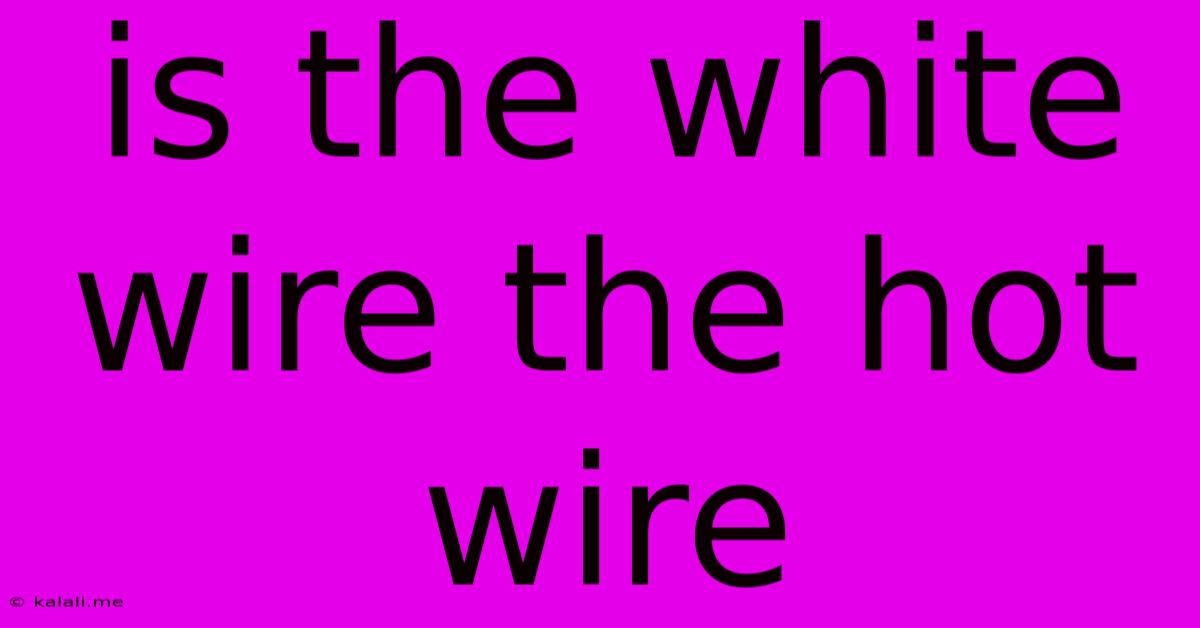Is The White Wire The Hot Wire
Kalali
Jun 09, 2025 · 3 min read

Table of Contents
Is the White Wire the Hot Wire? Understanding Electrical Wiring and Safety
Meta Description: Unravel the mystery of household wiring! This guide clarifies whether the white wire is hot, explaining color codes, safety precautions, and what to do if you encounter unexpected wiring. Learn to identify hot, neutral, and ground wires safely.
Understanding household wiring is crucial for home improvement projects and ensuring electrical safety. A common question among DIY enthusiasts and homeowners is: "Is the white wire the hot wire?" The simple answer is usually no, but it's essential to understand the nuances and exceptions. This article will delve into the complexities of electrical wiring, focusing on the role of the white wire and the importance of accurate identification.
The Standard Color Code: Neutral vs. Hot
In most standard residential wiring in North America, the white wire is the neutral wire. This wire carries the current back to the electrical panel after it's flowed through the load (like a light bulb or appliance). The hot wire, typically black or red, carries the energized current from the electrical panel to the load. A ground wire, usually bare copper or green, provides a safety path for stray current to prevent shocks.
Why the Confusion? Exceptions to the Rule
While the white wire is typically neutral, there are exceptions. Improper wiring, older homes, or specific circuit configurations can sometimes deviate from the standard color code. Here are a few scenarios where a white wire might be hot:
- Switched Neutral: In some lighting circuits, the neutral wire might be switched to control the light. This means the white wire could be energized in certain situations.
- Multi-Wire Branch Circuits (MWBCs): These circuits use a single cable with two hot wires and a neutral. One of the hot wires might be white in this setup. This is rare in modern homes, but important to know.
- Improper Wiring: Sadly, faulty or incorrect wiring is a possibility. This is why it’s crucial to always double-check using a non-contact voltage tester.
- Renovations and Alterations: Older homes that have undergone renovations might have wiring that doesn't adhere to modern standards.
Identifying Wires Safely: The Importance of Testing
Never assume the color of a wire determines its function. Always use a non-contact voltage tester or a multimeter to verify the voltage of a wire before touching it. This is a critical safety step. Incorrect identification can lead to serious electrical shock, injury, or even death.
What to Do If You Find Unexpected Wiring
If you discover wiring that doesn't conform to the standard color code, do not attempt to fix it yourself. Contact a qualified and licensed electrician. They have the expertise to correctly identify and resolve any wiring issues safely.
Beyond Color: Understanding the Role of Each Wire
Understanding the function of each wire type is crucial for electrical safety:
- Hot Wire (Black/Red): Carries the electrical current from the power source.
- Neutral Wire (White): Returns the current to the power source completing the circuit.
- Ground Wire (Bare Copper/Green): Provides a path for fault current to flow back to the ground, preventing electric shock.
Conclusion: Prioritize Safety
While the white wire is generally the neutral wire, relying solely on color is risky. Always test wires before working with them and contact a professional electrician if you encounter any uncertainty or non-standard wiring. Prioritizing safety is paramount when dealing with electricity. This article provides a basic understanding, but professional guidance is always recommended for electrical work.
Latest Posts
Latest Posts
-
Lutheran Vs Campus Crusade For Christ Beliefs
Jun 09, 2025
-
How To Get Out Of Werewolf Form Skyrim
Jun 09, 2025
-
What Is The Difference Between Pentecostal And Baptist
Jun 09, 2025
-
How Long Does It Take For Oncrete To Cure
Jun 09, 2025
-
What Is The Difference Between Grace And Mercy
Jun 09, 2025
Related Post
Thank you for visiting our website which covers about Is The White Wire The Hot Wire . We hope the information provided has been useful to you. Feel free to contact us if you have any questions or need further assistance. See you next time and don't miss to bookmark.